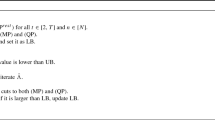Abstract
The contamination technique is presented as a flexible and relatively easily tractable tool to postoptimality analysis for scenario based multistage stochastic linear programs. It is promising especially in cases when the influence of additional or out-of-sample scenarios on the already solved problem is to be explored.
Similar content being viewed by others
References
S.P. Bradley and D.B. Crane, A dynamic model for bond portfolio management, Manag. Sci. 19 (1972) 139–151.
S.P. Bradley and D.B. Crane, Managing a bank bond portfolio over time, in:Stochastic Programming, ed. M.A.H. Dempster (Academic Press, London, 1980) pp. 449–471.
D.R. Cariño et al., The Russell-Yasuda Kasai model: An asset/liability model for a Japanese insurance company using multistage stochastic programming, Interfaces 24 (1994) 29–41.
D.R. Cariño et al., The Russell-Yasuda Kasai financial planning model, TR 93-MSC-018, Frank Russell Comp. (1993), submitted to Oper. Res.
H. Dahl et al., Some financial optimization models: II. Financial engineering, in:Financial Optimization, ed. S.A. Zenios (Cambridge University Press, 1993) pp. 37–71.
G.B. Dantzig and G. Infanger, Multi-stage stochastic linear programs for portfolio optimization, Ann. Oper. Res. 45 (1993) 59–76.
R.S. Dembo, Scenario optimization, Ann. Oper. Res. 30 (1991) 63–80.
M.A.H. Dempster and A.M. Ireland, A financial expert decision support system, in:Mathematical Models for Decision Support, ed. G. Mitra, NATO ASI Series Vol. 48 (Springer, Berlin, 1988) pp. 415–440.
J. Dupačová, Stability in stochastic programming with recourse: Contaminated distributions, Math. Prog. Study 27 (1986) 133–144.
J. Dupačová, Stochastic programming with incomplete information: A survey of results on post-optimization and sensitivity analysis, Optimization 18 (1987) 507–532.
J. Dupačová, Stability and sensitivity analysis for stochastic programming, Ann. Oper. Res. 27 (1990) 115–142.
J. Dupacová, Scenario based stochastic programs: Resistance with respect to sample, submitted to Ann. Oper. Res.
L.F. Escudero et al., Production planning and sourcing decisions via scenario modeling, Ann. Oper. Res. 42 (1993) 311–336.
O. Fiedler and W. Römisch, Stability in multistage stochastic programs, Ann. Oper. Res. (1995), this volume.
H.I. Gassmann, MSLiP: A computer code for the multistage stochastic linear programming problem, Math. Prog. 47 (1990) 407–423.
B. Golub et al., Stochastic programming models for portfolio optimizations with mortgage-backed securities, Euro. J. Oper. Res. (1994), to appear.
M. Holmer et al., Dynamic models for fixed-income portfolio management under uncertainty, Report 93-11-01, Decision Sciences Department, The Wharton School, University of Pennsylvania, Philadelphia (1993).
J.M. Hutchinson and S.A. Zenios, Financial simulations on a massively parallel connection machine, Int. J. Supercomp. Appl. 5 (1991) 27–45.
M.I. Kusy and W.T. Ziemba, A bank asset and liability management model, Oper. Res. 34 (1986) 356–376.
J. M. Mulvey, Generating scenarios for the Towers Perrin investment system, Research Report, Princeton University (1994).
J.M. Mulvey and H. Vladimirou, Stochastic network optimization models for investment planning, Ann. Oper. Res. 20 (1989) 187–217.
R.T. Rockafellar,The Theory of Subgradients and its Applications: Convex and Nonconvex Functions (Halderman, Berlin, 1981).
J.F. Shapiro, Stochastic programming models for dedicated portfolio selection, in:Mathematical Models for Decision Support, ed. B. Mitra, NATO ASI Series, Vol. F48 (Springer, Berlin, 1988) pp. 587–611.
R.J.-B. Wets, Stochastic programming, in:Handbook on OR & MS, Vol. 1, eds. G.L. Nemhauser et al. (North-Holland, Amsterdam, 1989) pp. 573–629.
S.A. Zenios, Massively parallel computations for financial planning under uncertainty, in:Very Large Scale Computation in the 21st Century, ed. J.P. Mesirov (SIAM Philadelphia, 1991) Chap. 18, pp. 273–294.
Author information
Authors and Affiliations
Additional information
Research supported in part by the Grant Agency of the Czech Republic under Grant No. 402/93/0631.
Rights and permissions
About this article
Cite this article
Dupačová, J. Postoptimality for multistage stochastic linear programs. Ann Oper Res 56, 65–78 (1995). https://doi.org/10.1007/BF02031700
Issue Date:
DOI: https://doi.org/10.1007/BF02031700




